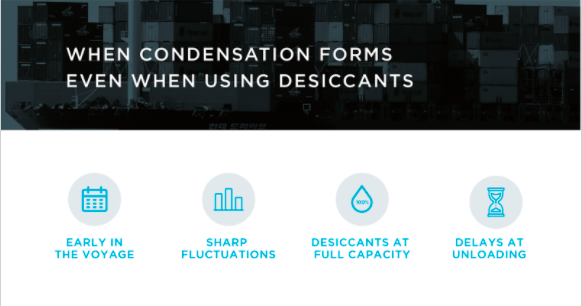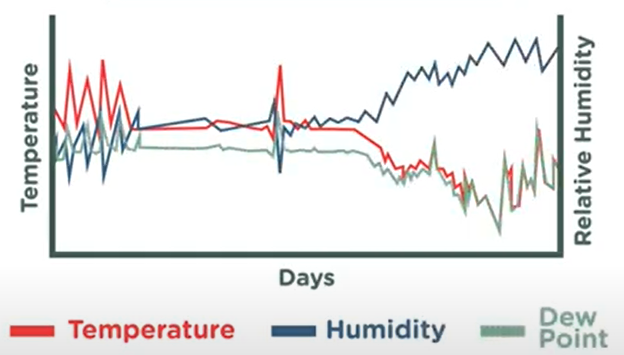You load your container with high-absorption cargo desiccants only to find the goods ruined by container rain damage at destination.
For your next shipment you add more cargo desiccants believing that will fix the problem. It doesn’t. The goods arrive soaked and unfit for purpose.
The reality is that the complex nature of container shipping means that often we have to take a step back to analyze the problem, instead of throwing more of the same in the search for a solution.
There are several periods during a voyage in which there is an increased risk of container rain damaging your shipment.
In these circumstances you could pack your container with 100kg of high-capacity cargo desiccants and still not be able to completely eliminate the risk of container rain damage.
Which is why we encourage shippers to move away from a one-dimensional approach to protecting cargo, and adopt a multi-solution strategy that interrupts the condensation cycle at different points.
Central to this philosophy is the Vdry Blanket. This high-capacity blanket hangs above the cargo and absorbs any drops of condensation that fall from the container ceiling, providing unbeatable protection even during periods of high risk.
To better understand why container rain forms even when using cargo desiccants, check out our below guide.
When the Container Rain Forms on the First Night
Within a few hours of loading, cargo is at risk of container rain damage. This is because condensation starts to form on the container ceiling once the temperature starts to fall on the first night of the voyage.
The problem is that cargo desiccants don’t suck up all the humidity from the air as soon as they are introduced to the shipping container.
Instead they work gradually, absorbing a little moisture each day over the course of the voyage.
This means that when the temperature drops on the first night the cargo desiccants haven’t been able to reduce the relative humidity within the container to prevent the dew point being reached.
This presents not only an immediate risk to cargo, but a risk that is repeated with the cyclical temperature fluctuations between day and night.
In this situation the Vdry Blanket is essential to ensure that your goods are protected from container rain at every stage of the voyage.

The Risk of Container Rain Mid-Voyage
Throughout the shipment the goods inside the container will be exposed to extreme temperature and fluctuations. These conditions are often significantly greater than ambient as the metal container walls heat up and cool with the cyclical temperature changes between day and night.
These fluctuations directly lead to condensation forming inside the container which is what leads to cargo moisture damage.
Because of the complex nature of international shipping which can see vessels cross the equator or move from one climatic region to another, the changes within the container can happen very quickly.
In these circumstances cargo desiccants do not have enough time to absorb sufficient quantities of humidity before condensation forms. This leaves goods exposed to container rain.
During these periods the Vdry Blanket provides peerless protection even in the face of heavy container rain.
When Cargo Desiccants Reach Capacity
Towards the end of a shipment it is likely that your cargo desiccants have reached full capacity. This means they are unable to absorb any more humidity from the container air.
Unfortunately this is the time when goods are most at risk. During unloading the conditions within the container fluctuate greatly due to exposure to direct sunlight, which leads to container rain forming.
Any delays at this point will increase the risk of damage to the cargo.
As you can see in the below graph container rain regularly forms throughout a voyage, with extended periods common towards the end of a shipment.
During these periods of increased risk the Vdry Blanket is invaluable in providing ever-present protection by absorbing any container rain that forms.

